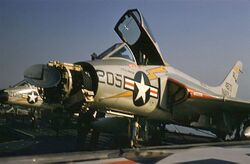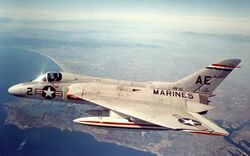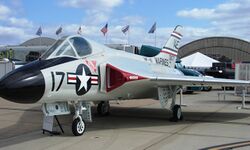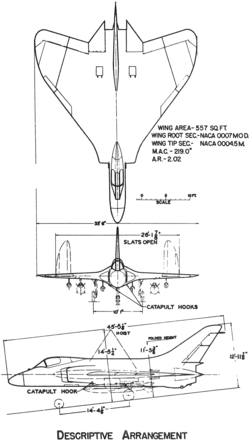Engineering:Douglas F4D Skyray
| F4D (F-6) Skyray | |
|---|---|
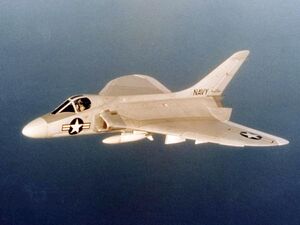
| |
| Role | Fighter aircraft |
| Manufacturer | Douglas Aircraft Company |
| First flight | 23 January 1951 |
| Introduction | 1956 |
| Retired | 1964 |
| Status | Retired |
| Primary users | United States Navy United States Marine Corps |
| Produced | 1950–1958 |
| Number built | 422 |
| Developed into | Douglas F5D Skylancer |
The Douglas F4D Skyray (later redesignated F-6 Skyray) is an American carrier-based fighter/interceptor designed and produced by the Douglas Aircraft Company. It was the last fighter produced by the Douglas Aircraft Company prior to its merger with McDonnell Aircraft to become McDonnell Douglas.
Development of the Skyray was started by Douglas during the late 1940s as the D-571-1 design study. It was a delta wing interceptor capable of a high rate of climb as to permit the rapid interception of approaching hostile bombers. Douglas' proposal was selected by Navy officials to fulfil a formal requirement issued in 1948. The decision to adopt the Westinghouse J40 turbojet engine to power it would lead to considerable difficulties later on as this engine would be cancelled prior to entering production. Aerodynamic issues would also lead to a protracted development cycle, considerable design changes being made even after the maiden flight of a production standard Skyray having taken place in June 1954. The Skyray was declared ready for fleet introduction in April 1956, permitting its entry to service with both the United States Navy (USN) and United States Marine Corps (USMC) shortly thereafter.
The Skyray had a relatively brief service life, during which it never participated in actual combat. Despite this, it was the first carrier-launched aircraft to hold the world's absolute speed record, having attained a top speed of 752.943 mph,[1][2] (1,211.744 km/h).[3] It also set a new time-to-altitude record, flying from a standing start to 49,221 feet (15,003 m) in two minutes and 36 seconds, all while flying at a 70° pitch angle. The last Skyrays were withdrawn from service in February 1964, although a handful continued to be flown for experimental purposes by National Advisory Committee for Aeronautics (NACA) up to the end of the decade. The F5D Skylancer was an advanced development of the F4D Skyray that ultimately did not enter service.
Design and development
The Skyray originated within a design study, the D-571-1, performed by Douglas and funded by the United States Navy (USN). It was a fast-climbing pure interceptor that used a delta wing configuration and powered by a pair of Westinghouse J34 turbojet engines, which were equipped with afterburners for bursts of additional acceleration.[4] The D-571-1 had a relatively thick wing with no conventional fuselage save for a pod-like cockpit in a forward position. A total of four 20mm cannons extended forward of the leading edge of the wing, alternative armaments consisted of spin-stabilized rockets.[5] The design study had harnessed the designs and research of the German aerodynamicist Alexander Lippisch, who moved to the United States following the end of World War II; his work had been examined by several of Douglas' design team.[6] In June 1947, the Navy issued a contract to Douglas to proceed with preliminary investigation and engineering works on the concept up to the mockup stage.[5]
As the design was refined, it was decided to substantially reduce the wing's thickness to increase its high speed capabilities.[7] The twin J34 engine arrangement was also swapped out for a single Westinghouse J40 engine. Only a single hydraulic system was incorporated, thus measures to permit manual reversion in the event of hydraulic failure were also included.[8] Rockets also became the primary armament, which were housed in pylon-mounted pods underneath the wing. A formal operational requirement was issued by the Navy in 1948, however, according to aviation author Tommy H. Thomason, it was an apparently foregone conclusion that the contract would be awarded to Douglas from the onset.[8] Specifics of this requirement included the ability to intercept and destroy an enemy aircraft at an altitude of 50,000 ft (15,240 m) within five minutes of the alarm being sounded.[9] At the time, Navy planners were particularly concerned by the threat posed to its carrier battle groups by high altitude Soviet bomber aircraft; furthermore, as early jet aircraft were fuel hungry and had limited endurance, to maximise an interceptor aircraft time on station it was particularly desirable for such an aircraft to possess a relatively high rate of climb so that it could be launched and rapidly reach its operational altitude.[10]

On account of the numerous design changes, the mockup review was delayed by almost one year, taking place in March 1949.[11] One criticism produced at this stage was that the nose-up attitude was greater than had been anticipated, necessitating changes to the aircraft's nose and radome to improve the pilot's external visibility.[11] A more pressing issue would be the J40 engine intended to power the aircraft. Douglas' design team had decided to make accommodations to facilitate the use of other engines as a contingency measure;[12] this approach proved to be quite fortunate as the J40 had a particularly troubled development, being eventually cancelled with no production units ever being delivered.[13] As a temporary measure, the prototype had to be outfitted with an Allison J35 engine instead.[6]
The long-term replacement for the J40 on production aircraft was the Pratt & Whitney J57, a more powerful but considerably larger engine. As the original inlet design was not a good match for the J57, it had to be redesigned.[14] The ensuing delays to the programme led to several other aircraft, such as the North American F-100 Super Sabre and the Mikoyan-Gurevich MiG-19, beating it into operational service.[6]
During June 1954, the first flight of a production standard Skyray occurred, after which an intense period of flight testing and remedial design work followed.[12] The aft section needed to be reprofiled to eliminate undesirable buffeting as well as to reduce drag. In September 1955, initial carrier suitability trials were performed onboard USS Ticonderoga.[12] No production aircraft were delivered until early 1956, it was declared ready for fleet introduction in April of that year.[12] A total of 419 F4D-1 (later designated F-6 under the unified designation system) aircraft would be produced prior to the end of production in 1958.
The Skyray was a wide delta wing design with long, sharply swept, rounded wings. It was named for its resemblance to the manta ray.[15] The thick wing roots contained the air intakes that fed its single turbojet engine. Fuel was contained both in the wings and the deep fuselage. Leading edge slats were fitted for increased lift during takeoff and landing while the trailing edges comprised mostly elevon control surfaces.[8] Additional pitch trimmers were fitted inboard near the jet exhaust, and were locked upwards on takeoff and landing. It had a relatively unique design for the era, which was a key factor in the Skyray becoming one of the best-known early jet fighters. It was affectionately known as the "Ford" (after the "Four" and "D" of its designation).[16] During 1953, Edward H. Heinemann was awarded the Collier Trophy in recognition of his design work on the F4D.[17]
Operational history
During April 1956, VC-3 became the first squadron to attain operational status with the F4D-1.[1] This unit was later redesignated VFAW-3 and assigned to NORAD, becoming the only United States Navy fighter squadron in what was predominantly a United States Air Force (USAF) and Royal Canadian Air Force (RCAF) organization. VFAW-3 was permanently based at NAS North Island in San Diego.
The United States Marine Corps (USMC) also operated the Skyray. When the Department of Defense adopted a uniform aircraft designation system patterned on the USAF's aircraft designation system during September 1962, the F4D was redesignated as the F-6A Skyray. The F4D (old designation) should not be confused with the F-4D (new designation) – the latter being the "D" variant of the McDonnell Douglas F-4 Phantom II operated by the USAF.[18]
The Skyray was designed exclusively for the high-altitude interception role, with a high rate and angle of climb. It set a new time-to-altitude record, flying from a standing start to 49,221 feet (15,003 m) in two minutes and 36 seconds, all while flying at a 70° pitch angle.[1] As a dedicated interceptor, the F4D was unsuited to the multi-mission capabilities that became increasingly in demand, thus the type had a relatively short career in both USN and USMC service. In addition to multiple Navy and Marine Corps squadrons, Naval Air Reserve and Marine Air Reserve squadrons VF-881, VF-882 and VMF-215 also flew the Skyray. The last operational squadron was VMF(AW)-115, which flew the Skyray until February 1964. A total of four aircraft were used for experimental purposes by the National Advisory Committee for Aeronautics (NACA) (which was later renamed NASA) until 1969.[19]
F5D Skylancer
The F5D Skylancer was derived from the F4D and intended to be a Mach 2 capable successor to the Skyray. Although four prototypes were built and flown, the project was cancelled as being too similar in mission parameters to the F8U Crusader and also to reduce dependence upon Douglas Aircraft, which was also producing several other aircraft for the U.S. Navy.[19][20] This decision effectively removed Douglas from active fighter development.[21]
Variants
- XF4D-1
- Prototypes; redesignated YF-6A in 1962, two built.
- F4D-1
- Single-seat fighter aircraft, production model; redesignated F-6A in 1962, 420 built.
- F4D-2
- Re-engined F4D-1 with the J57-F-14, 100 on order cancelled.
- F4D-2N
- F4D-2 version with extended nose housing twin radar scanners, project only evolved into the F5D Skylancer.
Operators
 United States
United States
- United States Navy
- VFAW-3
- VF-13
- VF-21
- VF-23
- VF-51
- VF-74
- VF-101
- VF-102
- VF-141
- VF-162
- VF-213
- VF-881
- VF-882
- United States Marine Corps
- VMF-113
- VMF-114
- VMF-115
- VMF-215
- VMF-314
- VMF-513
- VMFA-531
- VMF(AW)-542
- VX-3
- NACA/NASA
Aircraft on display
- XF4D-1
- 124587 – U.S. Naval Museum of Armament and Technology at Naval Air Weapons Station China Lake, California . It is on loan from the National Naval Aviation Museum, Naval Air Station Pensacola, Florida.[22]
- F4D-1 (F-6A)
- 134748 – Pima Air and Space Museum adjacent to Davis–Monthan Air Force Base in Tucson, Arizona. It is on loan from the National Naval Aviation Museum.[23]
- 134764 – Naval Air Station Patuxent River in St. Mary's County, Maryland. It is on loan from the National Naval Aviation Museum.[24]
- 134806 – National Naval Aviation Museum at Naval Air Station Pensacola, Florida.[25]
- 134836 – Intrepid Sea, Air & Space Museum in New York City . Originally on display at the New England Air Museum before relocating to Intrepid in 2021.[26]
- 134936 – Pueblo Weisbrod Aircraft Museum at Pueblo Memorial Airport, Colorado.[27]
- 134950 – Aviation Heritage Park at Naval Air Station Oceana in Virginia Beach, Virginia. It is on loan from the National Naval Aviation Museum.[28]
- 139177 – Flying Leatherneck Aviation Museum at Marine Corps Air Station Miramar in San Diego, California. It is on loan from the National Naval Aviation Museum.[29]
Specifications (F4D-1)
Data from The American Fighter[1]
General characteristics
- Crew: 1
- Length: 45 ft 3 in (13.79 m)
- Wingspan: 33 ft 6 in (10.21 m)
- Height: 13 ft 0 in (3.96 m)
- Wing area: 557 sq ft (51.7 m2)
- Airfoil: root: NACA 0007-63/30-9.5; tip: NACA 0004-5 63/30-9.5[30]
- Empty weight: 16,024 lb (7,268 kg)
- Gross weight: 22,648 lb (10,273 kg)
- Max takeoff weight: 27,116 lb (12,300 kg)
- Powerplant: 1 × Pratt & Whitney J57-P-8, −8A or −8B afterburning turbojet engine, 10,200 lbf (45 kN) thrust dry, 16,000 lbf (71 kN) with afterburner
Performance
- Maximum speed: 627 kn (722 mph, 1,161 km/h) at sea level
- Range: 610 nmi (700 mi, 1,130 km)
- Ferry range: 1,040 nmi (1,200 mi, 1,930 km)
- Service ceiling: 55,000 ft (17,000 m)
- Rate of climb: 18,300 ft/min (93 m/s)
- Wing loading: 41 lb/sq ft (200 kg/m2)
- Thrust/weight: 0.71
Armament
- Guns: 4 × 20 mm Colt Mk 12 cannon, two on each wing just aft of the leading edge, mid-wing, underside, with 65 rounds/gun
- Rockets:
- 6 pods of 7 2.75 in (70 mm) unguided rockets or
- 4 pods of 19 2.75 in (70 mm) unguided rockets
- Missiles: 4 × AIM-9 Sidewinder air-to-air missiles
- Bombs: 2 × 2,000 lb (907 kg) bombs
Avionics
- APQ-50A radar
- Aero 13F fire-control radar
See also
Related development
Aircraft of comparable role, configuration and era
- Dassault Super Mystere
- Grumman F-9 Cougar
- Grumman F-11 Tiger
- McDonnell F3H Demon
- North American FJ-4 Fury
- Vought F7U Cutlass
Related lists
- List of fighter aircraft
- List of United States Navy aircraft designations (pre-1962)
References
Citations
- ↑ 1.0 1.1 1.2 1.3 Angelluci 1987, p. 92.
- ↑ Caygill 2006, p. 175.
- ↑ Francillon 1979, p. 480.
- ↑ Thomason 2008, pp. 129, 143.
- ↑ 5.0 5.1 Thomason 2008, p. 143.
- ↑ 6.0 6.1 6.2 Caygill 2006, p. 157.
- ↑ Thomason 2008, pp. 143-144.
- ↑ 8.0 8.1 8.2 Thomason 2008, p. 144.
- ↑ Angelluci 1987, p. 91.
- ↑ Thomason 2008, pp. 128-129, 143.
- ↑ 11.0 11.1 Thomason 2008, p. 146.
- ↑ 12.0 12.1 12.2 12.3 Thomason 2008, p. 152.
- ↑ Thomason 2008, p. 129.
- ↑ Thomason 2008, pp. 151-152.
- ↑ Gunston 1981, p. 67.
- ↑ Gunston 1981, p. 70.
- ↑ "Collier Trophy awards." National Aeronautic Association. Retrieved: 27 February 2008.
- ↑ Thomason 2008, p. 266.
- ↑ 19.0 19.1 Gunston 1981, p. 73.
- ↑ Thomason 2008, pp. 230-231.
- ↑ Thomason 2008, p. 262.
- ↑ "F4D Skyray/124587." warbirdregistry.org Retrieved: 26 October 2012.
- ↑ "F4D Skyray/134748." Pima Air and Space Museum. Retrieved: 27 January 2015.
- ↑ "F4D Skyray/134764." aerialvisuals.ca Retrieved: 27 January 2015.
- ↑ "F4D Skyray/134806." National Naval Aviation Museum. Retrieved: 27 January 2015.
- ↑ "Intrepid Museum Skyray." Intrepid Sea, Air & Space Museum. Retrieved: 24 April 2022.
- ↑ "F-4D Skyray/134936." Pueblo Weisbrod Aircraft Museum. Retrieved: 29 February 2008.
- ↑ "F4D Skyray/134950." aerialvisuals.ca Retrieved: 27 January 2015.
- ↑ "F4D Skyray/139177." Flying Leatherneck Aviation Museum. Retrieved: 27 January 2015.
- ↑ Lednicer, David. "The Incomplete Guide to Airfoil Usage". https://m-selig.ae.illinois.edu/ads/aircraft.html.
Bibliography
- Angelucci, Enzo (1987). The American Fighter. Sparkford, Somerset, UK: Haynes Publishing Group. ISBN 0-85429-635-2.
- Caygill, Peter (2006). Sound Barrier: The Rocky Road to MACH 1.0+. Casemate Publishers. ISBN 1-84415-456-4. https://books.google.com/books?id=oBvOAwAAQBAJ&pg=PA157.
- Francillon, René J. (1979). McDonnell Douglas Aircraft since 1920. London, UK: Putnam. ISBN 0-370-00050-1.
- Frankel, Mark (2010). Killer Rays: The Story of the Douglas F4D Skyray and F5D Skylancer. North Branch, Minnesota, US: Specialty Press. ISBN 978-1-58007-155-0.
- Green, William; Pollinger, Gerald (1955). The Aircraft of the World. London, UK: Macdonald.
- Gunston, Bill (1981). Fighters of the Fifties. Cambridge, UK: Patrick Stephens Limited. ISBN 0-85059-463-4.
- Posey, Carl (July 2006). "Beautiful Climber". Air & Space.
- Williams, Nick; Ginter, Steve (1986). "Douglas F4D Skyray". Naval Fighters No. 13.. Simi Valley, California, US: Ginter Books. ISBN 0-942612-13-2.
- Winchester, Jim, ed (2006). "Douglas F4D Skyray". Military Aircraft of the Cold War (The Aviation Factfile). London, UK: Grange Books. ISBN 1-84013-929-3.
- Winchester, Jim (2006). Fighter: The World's Finest Combat Aircraft, 1913 to the Present Day. New York, US: Barnes & Noble Publishing and Parragon Publishing. ISBN 0-7607-7957-0.
- Roux, Élodie (2007). Turbofan and turbojet engines: database handbook. Ed. Elodie Roux. ISBN 978-2-9529380-1-3. https://books.google.com/books?id=_5vA_5XK33sC&pg=PA262. Retrieved 28 January 2019.
- Encyclopédie illustrée de l'aviation n°196 - Editions Atlas
- Thomason, Tommy H. (2008). U.S. Naval Air Superiority: Development of Shipborne Jet Fighters, 1943-1962. Specialty Press. ISBN 978-1-58007-110-9. https://books.google.com/books?id=XkYcBQAAQBAJ.
External links
 |
